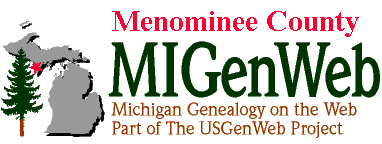Ingallston Township
|
Organization
Soon after the little settlements at Menominee and Cedar River had taken root a few people began to make homes for themselves along the bay shore where they could travel by boat in summer and over the ice in winter. With no roads and only a trail near the shore there was no move to settle far inland until somewhat later.
All of the bay shore was a part of Cedarville Township as mapped in 1863 when the county was organized; but in 1867 the plan was made to split the county lengthwise into three townships ~ Menominee, Ingallston, and Cedarville ~ instead of the two parts Menominee and Cedarville. There were, however, so very few people in the neighborhood of Ingallston that about six years passed before it organized and elected officers.
Because the first mill was set up by the Ingalls Brothers their name was given to the little settlement that resulted and to the township.
Settlement Near the Bay Shore
As early as 1858 Mathias Bailey came across Green Bar from Egg Harbor in Door County, Wisconsin and began fishing operations in the locality marked by projections of red rock and named Rochereaux Point. When the Civil War broke out he enlisted as a soldier and after receiving his discharge returned to Egg Harbor where he married. Before long he was again fishing in Michigan waters and moved his family to the vicinity of Arthur Bay as it is now called. One of his sons, Charles Bailey, still resides here and for many years carried the mail from Menominee to the post-offices along the shore. A few other fishermen also worked along the Green Bay shore in early days.
The Ingalls Mill on the Bay Shore
The Ingallston mill in the the township of Ingallston was built in the fall of 1866 by Charles B. Ingalls and Judge E.S. Ingalls. Judge Ingalls bargained his interest in it to Charles Ingalls during the winter of 1867-68. Charles operated it for a season then bargained it to Barnard & Wyley, who failed to keep their bargain. Afterwards, it was run by Carter & Jones, then finally Jesse L. Hamilton who was operating it on a contract with C.B. Ingalls when it was burned in the spring of 1874.
The Mellen Smith Mill
Mellen Smith built a shingle mill on the bay shore in the fall of 1872. It was in Ingallston about three-fourths of a mile from the Ingallston mill. It was soon moved back from the shore.
Early Industries
One of the pioneers who came to the shore in 1867 was Robert Beattie, a fisherman. His name was given to Beattie Creek. His brother, Hugh, joined him two years later. Two others pioneers who settled in the Ingallston neighborhood about the same time as Robert Beattie were Owen Gartland and Louis Grabowsky.
Owen Gartland was a cooper and made kegs for the fishermen who carried on their fishing operations offshore. Other early fishermen were Charles and Edwin Quimby and John Nelson. For a time, Mr. & Mrs. Edwin Quimby managed the large boarding house erected by the Ingalls Brothers to accommodate mill workers.
It took only a few years before the logging industry superseded everything else. A booming little town, Arthur Bay (or Leathemville, as it was called) handled supplies for many of the camps. In a few years though, the boom flattened out and Arthur Bay settled back down to the quieter life of fishing and farming.
|
